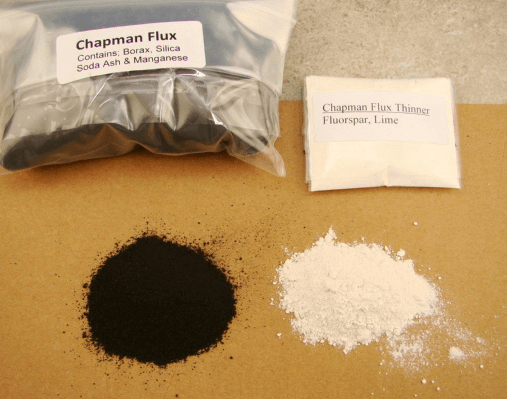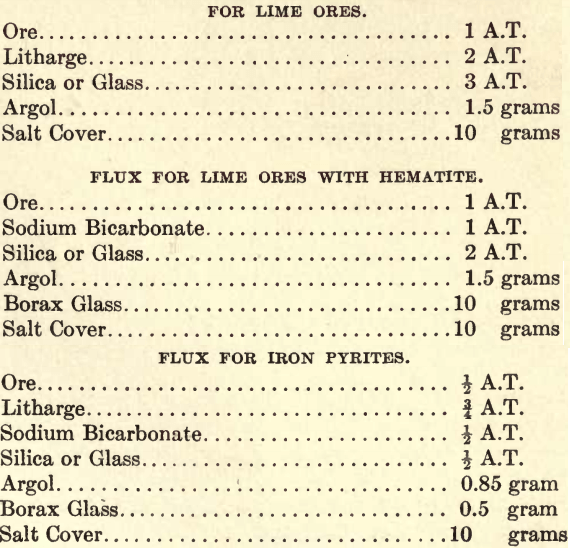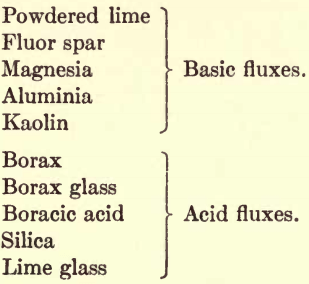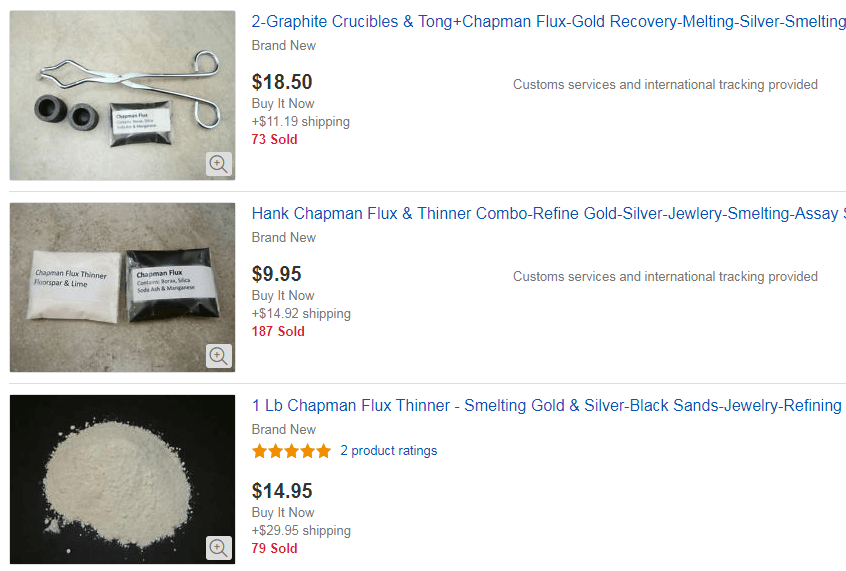Table of Contents

General Flux
In a laboratory where much work is done in a day, and the class of ore is uniform, what is called a “general smelting flux” may be made. This flux is adapted to ores that may be classified as average, but is so compounded as to allow the addition of extra litharge and reducing agent. A general flux of this nature may be made of the following ingredients:
3½ pounds of litharge, free from silver (lead oxide)
3 pounds of sodium bicarbonate
2 pounds of borax glass
1 pound of silica or powdered glass
3 ozs. of flour.
Mix these thoroughly through a 40 mesh sieve. The object of preparing this general flux is to save the necessity of weighing out the flux for each individual assay sample. This flux does not contain quite enough litharge for an average ore, and for average ores about twelve grams of litharge should be added to the charge. The reason for omitting this amount of litharge in the flux is that in the case of ores containing lead too large a lead button would result. In fluxing an average gold and silver ore, weigh 1 assay ton of ore and add 12 grams of litharge and 2½ assay tons of the general flux. In the fluxing of an ore containing lead omit the addition of the litharge. These brief instructions as to using general flux are presented in order that the student may have a starting point, and his subsequent experience will enable him to make changes to fit varying conditions.
The weighing of fluxes for each and every assay may be avoided by using measures of known capacity. These measures will save the time spent in weighing.
Specific Fluxes or Flux for Specific Cases

Fluxes Generally Used & Functions
Sodium Bicarbonate—Basic Oxidizer; Desulphurizer.
Potassium Cyanide—Reducer and Desulphurizer for lead assay.
Argol—Basic Flux; Reducer.
Charcoal—Reducer and Deoxidizer.
Starch, Flour, Sugar—Reducer.
Metallic Iron —Desulphurizer.
Lead and Lead Oxide (Litharge)—Basic Flux; Oxidizer.
Nitre—Basic Flux and Oxidizer.

Scorification Fluxes
To scorify the following, take:
Galena.—1/10, A.T. Test, Lead 16 grams, Borax Glass about 0.5 gram.
Lead Carbonate.—1/10, A.T. Test, Lead 16 grams, Borax Glass about 0.5 gram.
Lead Matte.—1/10, A.T. Test, Lead 30 grams. Borax Glass about 0.75 gram.
Iron Pyrites.—1/10, A.T. Test, Lead 35 and 10 grams (grams litharge), Borax Glass about 0.5 gram
Gray Copper.—1/10, A.T. Test, Lead 50 grams, Borax Glass about 0.5 gram.
Copper Matte.—1/10, A.T. Test, Lead 40 grams, Borax Glass about 0.5 gram.
Arsenical Pyrites.—1/10, A.T. Test, Lead 50 grams, Borax Glass about 1.0 gram.
Blendes.—1/10, A.T. Test, Lead 40 grams. Borax Glass about 0.5 gram.
Silicious Ore.—1/10, A.T. Test, Lead 30 grams, Borax Glass, none.
Tellurides.—1/10, A.T Test, Lead 00 grams, Borax Glass about 0.5 gram.
By practice the operator can determine whether more lead than given above gives higher results in silver. It is impossible to formulate an invariable system, as different conditions give different results.
The ore charges selected for scorifications vary from 1/10 (.1) to 1/5 (.02) assay ton. The size of scorifiers selected must be governed by the size of the ore charge.

